
California native plants
Encyclopedia
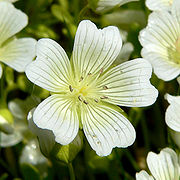
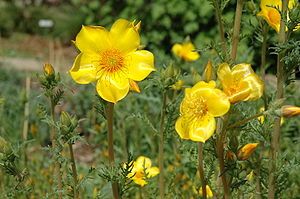
California
California is a state located on the West Coast of the United States. It is by far the most populous U.S. state, and the third-largest by land area...
prior to the arrival of European
European ethnic groups
The ethnic groups in Europe are the various ethnic groups that reside in the nations of Europe. European ethnology is the field of anthropology focusing on Europe....
explorers and colonists in the late 18th century. They grow in the California Floristic Province
California Floristic Province
The California Floristic Province is a floristic province with a Mediterranean climate located on the Pacific Coast of North America with a distinctive flora that bears similarities to floras found in other regions experiencing a winter rainfall, summer drought climate like the Mediterranean...
, a geographical area that covers most of California, portions of neighboring Oregon
Oregon
Oregon is a state in the Pacific Northwest region of the United States. It is located on the Pacific coast, with Washington to the north, California to the south, Nevada on the southeast and Idaho to the east. The Columbia and Snake rivers delineate much of Oregon's northern and eastern...
, Nevada
Nevada
Nevada is a state in the western, mountain west, and southwestern regions of the United States. With an area of and a population of about 2.7 million, it is the 7th-largest and 35th-most populous state. Over two-thirds of Nevada's people live in the Las Vegas metropolitan area, which contains its...
, and Baja California
Baja California
Baja California officially Estado Libre y Soberano de Baja California is one of the 31 states which, with the Federal District, comprise the 32 Federal Entities of Mexico. It is both the northernmost and westernmost state of Mexico. Before becoming a state in 1953, the area was known as the North...
, that is regarded as a 'world hotspot' of biodiversity
Biodiversity
Biodiversity is the degree of variation of life forms within a given ecosystem, biome, or an entire planet. Biodiversity is a measure of the health of ecosystems. Biodiversity is in part a function of climate. In terrestrial habitats, tropical regions are typically rich whereas polar regions...
.
Introduction
California is home to 5,862 species and 1,169 subspecies or varieties of native plants. This figure is comparable to all the species in all the other states combined. The Jepson Manual documents the state's ever changing botany statistics.Of California's total plant population, 2,153 species, subspecies, and varieties are endemic and native to California alone. This botanical diversity stems not only from the size of the state, but also its diverse topographies, climates, and soils (e.g. serpentine outcrops). Numerous plant groupings exist in California, and botanists work to structure them into identifiable ecoregions, plant communities, vegetation types, and habitats, and taxonomies.
Some California native plants have extraordinary horticultural appeal. Sometimes the appreciation was greater abroad first, such as Lupines, California Fuchsias
Zauschneria
Epilobium canum, known as Zauschneria, is a species of willowherb, native to dry slopes and in chaparral of western North America, especially California...
, and California Poppies
California poppy
The California poppy is a perennial and annual plant, native to the United States, and the official state flower of California.- Description :...
being cultivated in British and European gardens for over a century.
Common trees

Sequoias and redwoods
- Coast Redwood (Sequoia sempervirens) - in the fog-shrouded coast ranges.
- Giant SequoiaSequoiadendronSequoiadendron giganteum is the sole living species in the genus Sequoiadendron, and one of three species of coniferous trees known as redwoods, classified in the family Cupressaceae in the subfamily Sequoioideae, together with Sequoia sempervirens and...
(Sequoiadendron giganteumSequoiadendronSequoiadendron giganteum is the sole living species in the genus Sequoiadendron, and one of three species of coniferous trees known as redwoods, classified in the family Cupressaceae in the subfamily Sequoioideae, together with Sequoia sempervirens and...
) - in the Sierra Nevada MountainsSierra Nevada (US)The Sierra Nevada is a mountain range in the U.S. states of California and Nevada, between the California Central Valley and the Basin and Range Province. The Sierra runs north-to-south, and is approximately across east-to-west...
.
Common pine trees
- Bishop Pine — (Pinus muricata) - coastal species - gardens.
- Coulter Pine — (Pinus coulteri)
- Grey Pine - Digger Pine — (Pinus sabiniana)
- Knobcone Pine — (Pinus attenuata)
- Ponderosa Pine — (Pinus ponderosa) - well known in mountains
- Monterey Pine — (Pinus radiata) - naturally limited endemic - widely planted horticulturally around the world.
- Limber Pine — (Pinus flexilis)
- Jeffrey Pine — (Pinus jeffreyi)
- Parry Pinyon — (Pinus quadrifolia)
- Shore Pine — (Pinus contorta)
- Sugar Pine — (Pinus lambertiana)
- Torrey Pine — (Pinus torreyana)
- Western White Pine — (Pinus monticola)
- Single-leaf Pinyon Pine — (Pinus monophylla)
- Great Basin Bristlecone Pine — (Pinus longaeva) - the 'Methuselah'Methuselah (tree)Methuselah is a Great Basin Bristlecone Pine tree growing high in the White Mountains of Inyo County in eastern California. Its measured age of 4,842 years makes it the world's oldest known living non-clonal organism...
- 4,700 years old. - Foxtail Pine — (Pinus balfouriana) - Californian endemic; 2,000 year old specimens.
Other conifers
- Santa Lucia Fir — (Abies bracteata) and seven other native Abies species.
- Douglas-Fir — (Pseudotsuga menziesii)
- Bigcone Douglas-Fir — (Pseudotsuga macrocarpa) - Central CoastCentral Coast of CaliforniaThe Central Coast is an area of California, United States, roughly spanning the area between the Monterey Bay and Point Conception. It extends through Santa Cruz County, San Benito County, Monterey County, San Luis Obispo County, and Santa Barbara County...
and Santa Susana MountainsSanta Susana MountainsThe Santa Susana Mountains are a transverse range of mountains in southern California, north of the city of Los Angeles, in the United States. The range runs east-west separating the San Fernando Valley and Simi Valley on its south, from Santa Clara River Valley to the north, and Santa Clarita...
. - California NutmegTorreya californicaTorreya californica is species of conifer endemic to California, occurring in the Pacific Coast Ranges and the foothills of the Sierra Nevada...
— (Torreya californica) - Incense CedarCalocedrus decurrensCalocedrus decurrens is a species of conifer native to western North America, with the bulk of the range in the United States, from central western Oregon through most of California and the extreme west of Nevada, and also a short distance into northwest Mexico in northern Baja California...
— (Calocedrus decurrens) - Port Orford Cedar-Lawson CypressChamaecyparis lawsonianaChamaecyparis lawsoniana is a cypress in the genus Chamaecyparis, family Cupressaceae, known by the name Lawson's Cypress in the horticultural trade, or Port Orford-cedar in its native range . C...
— (Chamaecyparis lawsoniana) - White Fir (Abies concolor) - at high elevations.
- Mountain Hemlock (Tsuga mertensiana)
Oak trees
- California is home, often in oak woodlandsCalifornia oak woodlandCalifornia oak woodland is a plant community found throughout the California chaparral and woodlands ecoregion of California in the United States and northwestern Baja California in Mexico...
, to many deciduous and evergreen Oaks:- Valley Oak (Quercus lobata) - the giant.
- Leather OakQuercus durataQuercus durata is an oak endemic to California.Quercus durata var. durata is a strict serpentine endemic that occurs in the Coast Range and northern Sierra Nevadas. It is often a component of serpentine chaparral...
(Quercus durata) - the shrubby one - Blue Oak (Quercus douglasii) - in the Central Valley foothills and Coast Ranges
- California Black Oak (Quercus kelloggii) - in the higher hills mountains
- Canyon Live OakQuercus chrysolepisQuercus chrysolepis, commonly termed Canyon Live Oak, or Golden Cup Oak, is a species of evergreen oak that is found in the southwestern part of North America, notably in the California Coast Ranges. This tree is often found near creeks and drainage swales growing in moist cool microhabitats...
(Quercus chrysolepis) - in the higher hills - Interior Live Oak (Quercus wislizenii) in the Central ValleyCalifornia Central ValleyCalifornia's Central Valley is a large, flat valley that dominates the central portion of California. It is home to California's most productive agricultural efforts. The valley stretches approximately from northwest to southeast inland and parallel to the Pacific Ocean coast. Its northern half is...
region. - Island Oak (Quercus tomentella) - endemic with distinctive large evergreen leaves.
- Engelmann Oak (Quercus engelmanni) - shade giving with a cool blue-gray cast to the foliage.
- Coast Live Oak (Quercus agrifolia) is found in the Coast Ranges, Transverse RangesTransverse RangesThe Transverse Ranges are a group of mountain ranges of southern California, in the Pacific Coast Ranges physiographic region that runs along the Pacific coast from Alaska to Mexico in North America. The Transverse Ranges begin at the southern end of the California Coast Ranges and lie between...
, Peninsular RangesPeninsular RangesThe Peninsular Ranges are a group of mountain ranges, in the Pacific Coast Ranges, which stretch from southern California in the United States to the southern tip of Mexico's Baja California peninsula; they are part of the North American Coast Ranges that run along the Pacific coast from Alaska...
, and along the coast's hills and adjacent interior valleys, and many other habitats and gardens.
Riparian trees
- In Riparian areasRiparian zoneA riparian zone or riparian area is the interface between land and a river or stream. Riparian is also the proper nomenclature for one of the fifteen terrestrial biomes of the earth. Plant habitats and communities along the river margins and banks are called riparian vegetation, characterized by...
(streamside and moist habitats) some of the trees include:- California Sycamore (Platanus racemosa)
- White AlderAlnus rhombifoliaAlnus rhombifolia, the White Alder, is an alder tree native to western North America, from Washington east to western Montana, southeast to the Sierra Nevada, and south through the Peninsular Ranges and Colorado Desert oases in Southern California. It occurs in riparian zone habitats at an...
(Alnus rhombifolia) - Quaking Aspen (Populus tremuloides)
- Fremont CottonwoodPopulus fremontiiPopulus fremontii, the Fremont cottonwood or Alamo cottonwood, is a cottonwood poplar native to western North America, in California and east to Nevada, Utah, Arizona, and New Mexico, and south into Sonora in northwestern Mexico...
(Populus fremontii) - Black CottonwoodPopulus trichocarpaPopulus trichocarpa is a deciduous broadleaf tree species native to western North America. It is used for timber, and is notable as a model organism in plant biology. Its full genome sequence was published in 2006...
(Populus trichocarpa). - Arroyo WillowSalix lasiolepisSalix lasiolepis is a species of willow native to western and southwestern North America, in the United States from central and southern Washington and southwestern Idaho south to California and Texas, and in Mexico from the Baja California peninsula east to Coahuila and south to Jalisco. The name...
(Salix lasiolepis).
Other trees and tree-like shrubs
- Tanoak (Lithocarpus densiflorus)
- California Bay Laurel (Umbellularia californica)
- MadronePacific MadroneArbutus menziesii, commonly known as the Pacific Madrone, is a species of Arbutus found on the west coast of North America, from British Columbia to California...
(Arbutus menziesii) - Toyon (Heteromeles arbutifolia)
- Bigleaf Maple (Acer macrophyllum)
- Western Blue Elderberry (Sambucus mexicana) is found throughout the state, an important host for birds, butterfliesButterflyA butterfly is a mainly day-flying insect of the order Lepidoptera, which includes the butterflies and moths. Like other holometabolous insects, the butterfly's life cycle consists of four parts: egg, larva, pupa and adult. Most species are diurnal. Butterflies have large, often brightly coloured...
, pollinatorPollinatorA pollinator is the biotic agent that moves pollen from the male anthers of a flower to the female stigma of a flower to accomplish fertilization or syngamy of the female gamete in the ovule of the flower by the male gamete from the pollen grain...
s, and beneficial insectsBeneficial insectsBeneficial insects are any of a number of species of insects that perform valued services like pollination and pest control. The concept of beneficial is subjective and only arises in light of desired outcomes from a human perspective...
(Integrated pest management (IPM)Integrated Pest ManagementIntegrated pest management is an ecological approach to agricultural pest control that integrates pesticides/herbicides into a management system incorporating a range of practices for economic control of a pest...
). - California BuckeyeAesculus californicaAesculus californica is a species of buckeye that is native [ |] to California and southwest Oregon [Jackson, County], and the only buckeye native to these states.-Description:...
(Aesculus californica) - Western RedbudCercis occidentalisCercis occidentalis, the western redbud is a small tree or shrub in the legume family. It is found across the American Southwest, from California to Utah....
(Cercis occidentalis) - California Black WalnutJuglans californicaJuglans californica, the California black walnut, also called the California walnut, or the Southern California black walnut, is a large shrub or small tree of the Juglandaceae family endemic to California....
(Juglans californica) - California Hazelnut (Corylus cornuta)
Common shrubs
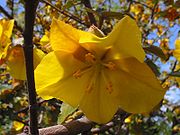
- Chamise or greasewoodGreasewoodGreasewood, Sarcobatus, is a genus of one or two species of flowering plants. Traditionally it has been treated in the family Chenopodiaceae, but the APG II system, of 2003, places it in the family Sarcobataceae....
(Adenostoma fasciculatumAdenostoma fasciculatumAdenostoma fasciculatum is a flowering plant native to California and northern Baja California. This shrub is one of the most widespread plants of the chaparral biome.-Description:...
) - Service-Berry (Amelanchier alnifolia)
- ManzanitaArctostaphylosArctostaphylos is a genus of plants comprised by the manzanitas and bearberries. They are shrubs or small trees.There are about 60 species of Arctostaphylos, ranging from ground-hugging arctic, coastal, and mountain species to small trees up to 6 m tall. Most are evergreen , with small oval...
(Arctostaphylos spp.ArctostaphylosArctostaphylos is a genus of plants comprised by the manzanitas and bearberries. They are shrubs or small trees.There are about 60 species of Arctostaphylos, ranging from ground-hugging arctic, coastal, and mountain species to small trees up to 6 m tall. Most are evergreen , with small oval...
) - Coyote BrushBaccharis pilularisBaccharis pilularis, called Coyote Brush , Chaparral Broom, and Bush Baccharis, is a shrub in the Asteraceae that grows in California, Oregon, and Baja California.-Description:...
(Baccharis pilularisBaccharis pilularisBaccharis pilularis, called Coyote Brush , Chaparral Broom, and Bush Baccharis, is a shrub in the Asteraceae that grows in California, Oregon, and Baja California.-Description:...
) - California LilacsCeanothusCeanothus L. is a genus of about 50–60 species of shrubs or small trees in the buckthorn family Rhamnaceae. The genus is confined to North America, the center of its distribution in California, with some species in the eastern United States and southeast Canada, and others extending as far south...
(Ceanothus spp.CeanothusCeanothus L. is a genus of about 50–60 species of shrubs or small trees in the buckthorn family Rhamnaceae. The genus is confined to North America, the center of its distribution in California, with some species in the eastern United States and southeast Canada, and others extending as far south...
) - Flannelbush (Fremontodendron spp.)
- Creosote BushCreosote bushLarrea tridentata is known as Creosote bush as a plant, chaparral as a medicinal herb, and as "gobernadora" in Mexico, Spanish for "governess," due to its ability for inhibiting the growth of nearby plants to have more water. In Sonora, it is more commonly called "hediondilla." It is a flowering...
(Larrea tridentata) - Lupines (Lupinus spp.)
- SnowberrySymphoricarposSymphoricarpos, with common names in English of Snowberry, Waxberry or Ghostberry, is a small genus of about 15 species of deciduous shrubs in the honeysuckle family, Caprifoliaceae. All species are natives of North and Central America, except one native to western China...
(Symphoricarpos mollisSymphoricarpos mollisSymphoricarpos mollis is a species of flowering plant in the honeysuckle family. It is found across western North America....
& spp.), - HuckleberryVacciniumVaccinium is a genus of shrubs or dwarf shrubs in the plant Family Ericaceae. The fruit of many species are eaten by humans and some are of commercial importance, including the cranberry, blueberry, bilberry or whortleberry, lingonberry or cowberry, and huckleberry...
(Vaccinium ovatum & spp.) - CoffeeberryRhamnus californicaRhamnus californica , is called coffeeberry because its berries contain seeds which look like coffee beans—it is also called California buckthorn...
(Rhamnus spp.) - Lemonade BerryRhus integrifoliaRhus integrifolia, also known as Lemonade Berry, Lemonadeberry, or Lemonade Sumac is a shrub to small tree. It is native to the Transverse and Peninsular Ranges and the South Coast regions of Southern California...
(Rhus integrifoliaRhus integrifoliaRhus integrifolia, also known as Lemonade Berry, Lemonadeberry, or Lemonade Sumac is a shrub to small tree. It is native to the Transverse and Peninsular Ranges and the South Coast regions of Southern California...
) - SugarbushRhus ovataRhus ovata, also known as Sugar Bush or Sugar Sumac, is an evergreen shrub to small tree that grows in chaparral in dry canyons and south-facing slopes below 1300 m in Southern California, Arizona and Baja California.-Distribution:...
(Rhus ovataRhus ovataRhus ovata, also known as Sugar Bush or Sugar Sumac, is an evergreen shrub to small tree that grows in chaparral in dry canyons and south-facing slopes below 1300 m in Southern California, Arizona and Baja California.-Distribution:...
) - Gooseberries + CurrantsRibesRibes is a genus of about 150 species of flowering plants native throughout the temperate regions of the Northern Hemisphere. It is usually treated as the only genus in the family Grossulariaceae. Seven subgenera are recognized....
(Ribes spp.RibesRibes is a genus of about 150 species of flowering plants native throughout the temperate regions of the Northern Hemisphere. It is usually treated as the only genus in the family Grossulariaceae. Seven subgenera are recognized....
) - SagesSalviaSalvia is the largest genus of plants in the mint family, Lamiaceae, with approximately 700-900 species of shrubs, herbaceous perennials, and annuals. It is one of several genera commonly referred to as sage. When used without modifiers, sage generally refers to Salvia officinalis ; however, it is...
(Salvia spp.SalviaSalvia is the largest genus of plants in the mint family, Lamiaceae, with approximately 700-900 species of shrubs, herbaceous perennials, and annuals. It is one of several genera commonly referred to as sage. When used without modifiers, sage generally refers to Salvia officinalis ; however, it is...
)
Desert plants
- Main: see Category: Flora of the California desert regions
- California Fan PalmWashingtonia filiferaWashingtonia filifera , with the common names California Fan Palm , Desert Fan Palm, Cotton palm, and Arizona Fan Palm. It is a palm native to southwestern North America between an elevation range of , at seeps, desert bajadas, and springs where underground water is continuously available...
(Washingtonia filifera) - Joshua tree (Yucca brevifolia)
- California JuniperJuniperus californicaJuniperus californica is a species of juniper native to southwestern North America; as the name implies, it is mainly found in California, although its range also extends through most of Baja California, a short distance into the Great Basin in southern Nevada, and western Arizona...
(Juniperus californica) - Blue Palo VerdeParkinsonia floridaParkinsonia florida is a species of palo verde native to the southwestern United States and northwestern Mexico...
(Parkinsonia florida) - Yellow Foothill Palo VerdeParkinsonia microphyllaParkinsonia microphylla is a species of palo verde native to the southwestern United States and northwestern Mexico .- Overview :It is a bristling, upright-branching tree, mostly found on slopes, and is one of the...
(Parkinsonia microphylla) - Single-leaf Pinyon (Pinus monophylla)
- Fremont CottonwoodPopulus fremontiiPopulus fremontii, the Fremont cottonwood or Alamo cottonwood, is a cottonwood poplar native to western North America, in California and east to Nevada, Utah, Arizona, and New Mexico, and south into Sonora in northwestern Mexico...
(Populus fremontii) - Ocotillo (Fouquieria splendens)
- Creosote bush (Larrea tridentata)
- Indian MallowAbutilon palmeriAbutilon palmeri is a species of Abutilon native the southwestern United States and northern Mexico.-Description:...
(Abutilon palmeri) - BrittlebushEncelia farinosaEncelia farinosa, or Brittlebush, is a common desert shrub of northwestern Mexico through California and the southwestern United States. Its common name comes from the brittleness of its stems....
(Encelia farinosa) - Desert AgaveAgave desertiAgave deserti is an agave native to desert regions in southern California, Arizona, and Baja California...
(Agave deserti) - California barrel cactusFerocactus cylindraceusFerocactus cylindraceus is a species of barrel cactus which is known by several common names, including California barrel cactus and miner's compass. It was first described by George Engelmann in 1853. This cactus is usually cylindrical or spherical, with some older specimens forming columns two...
(Ferocactus cylindraceus) - Banana yucca (Yucca baccata)
- Mojave yucca (Yucca schidigera)
- Rush milkweedAsclepias subulataAsclepias subulata is a species of milkweed known commonly as the rush milkweed or ajamete. This is an erect perennial herb which loses its leaves early in the season and stands as a cluster of naked stalks. Atop the stems are inflorescences of distinctive flowers...
(Asclepias subulata) - Purple Desert sand-verbenaAbronia villosaAbronia villosa is a species of sand-verbena known by the common name desert sand-verbena. It is native to the deserts of the southwestern United States and northern Mexico and the southern California and Baja coast.-Description:...
(Abronia villosa) - Sacred DaturaDatura wrightiiDatura wrightii or Sacred Datura is the name of a poisonous perennial plant and ornamental flower of southwestern North America. It is sometimes used as a hallucinogen. Datura wrightii is classified as a deliriant and an anticholinergic....
(Datura wrightii)
Common perennials
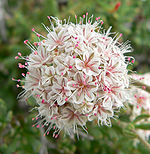
Sunny habitats
- California PoppyCalifornia poppyThe California poppy is a perennial and annual plant, native to the United States, and the official state flower of California.- Description :...
(Eschscholzia californica) are found in drier places. California poppies are also an annual in many places. - Douglas Iris (Iris douglasiana) and 'Pacific Coast' hybrids.
- MonkeyflowerMimulusMimulus is a diverse plant genus, the monkey-flowers and musk-flowers. The about 150 species are currently placed in the family Phrymaceae. The genus has traditionally been placed in Scrophulariaceae. The removal of Mimulus from that family has been supported by studies of chloroplast DNA first...
- i.e.: Mimulus aurantiacusMimulus aurantiacusMimulus aurantiacus, the Sticky monkey-flower and Orange bush monkey-flower, is a flowering plant that grows in a subshrub form, native to southwestern North America from southwestern Oregon south through most of California...
, Mimulus guttatusMimulus guttatusMimulus guttatus, the Common monkey-flower, is a yellow bee-pollinated annual or perennial herbaceous wildflower that grows along the banks of streams and seeps in western North America.-Description:...
, Mimulus cardinalisMimulus cardinalisMimulus cardinalis, the scarlet monkeyflower, is a flowering perennial in the family Phrymaceae. Together with other species in Mimulus section Erythranthe, it serves as a model system for studying pollinator-based reproductive isolation....
and cultivars. - ColumbineAquilegiaAquilegia is a genus of about 60-70 species of perennial plants that are found in meadows, woodlands, and at higher altitudes throughout the Northern Hemisphere, known for the spurred petals of their flowers.-Etymology:The genus name Aquilegia is derived from the Latin word for eagle , because...
- (Aquilegia|Aquilegia spp.) - Coyote MintMonardellaMonardella is a genus of 28 species of annual and perennial plants native to western North America. They are grown for their highly aromatic foliage, which in some species is used for herbal teas...
- (Monardella spp.) - BuckwheatsEriogonumEriogonum is the scientific name for a genus of flowering plants, in the family Polygonaceae. The genus is found in North America and is known as wild buckwheat. This is a highly species-rich genus, and indications are that active speciation is continuing...
- (Eriogonum fasciculatumEriogonum fasciculatumEriogonum fasciculatum is a species of wild buckwheat known by the common names California buckwheat and Eastern Mojave buckwheat. This common shrub is native to the southwestern United States and northwestern Mexico, where it grows on scrubby slopes and in chaparral and dry washes in a number of...
), (Eriogonum giganteumEriogonum giganteumEriogonum giganteum is a species of wild buckwheat.-Description:Eriogonum giganteum is variable in size, from a thin half a meter in height and width to a sprawling or rounded bush over three meters high and wide. The leathery, woolly, oval-shaped leaves are clustered sparsely along the mostly...
), (Eriogonum umbellatumEriogonum umbellatumEriogonum umbellatum is a species of wild buckwheat known by the common name sulphurflower buckwheat, or simply sulphur flower. It is native to western North America from California to Colorado to central Canada, where it is abundant and found in many habitats...
)
Shady habitats
- Western wild gingerAsarum caudatumAsarum caudatum is native to rich moist forests of western North America from British Columbia to California and as far east as western Montana....
- (Asarum caudatum) - Pacific bleeding-heartDicentra formosaDicentra formosa is a herbaceous perennial growing from a rhizome, native to moist woodland from California to British Columbia.-Description:...
- (Dicentra formosa) - Island Coral BellsHeuchera maximaHeuchera maxima is a species of flowering plant in the saxifrage family known by the common names island alumroot and Jill-of-the-Rocks. It is endemic to three of the eight Channel Islands of California, where it grows on cliffs. It is also cultivated as an attractive garden plant...
- (Heuchera maxima) - Canyon Coral BellsHeuchera hirsutissimaHeuchera hirsutissima is a species of flowering plant in the saxifrage family known by the common name shaggy-haired alumroot. It is endemic to the San Jacinto Mountains of Riverside County, California, where it grows on rocky slopes. While uncommon in the wild, this species is cultivated as an...
- (Heuchera hirsutissima) - Hairy Purple BellsHeuchera villosaHeuchera villosa, the Hairy Alumroot, is a small evergreen perennial native to Appalachia. and the Northeastern, Southeastern, and parts of Central United States.....
- (Heuchera villosa) - HeucherellaHeucherellaHeucherella is a perennial flowering plant that is a hybrid of Heuchera and Tiarella.There are several different kinds of Heucherella plants depending on the parentage of the Heuchera and the Tiarella and they all have different characteristics...
- Threeleaf FoamflowerTiarella trifoliataTiarella trifoliata is a dicot in the family Saxifragaceae. It is a perennial herb that grows in the late spring. It is endemic to the low to moderate elevation moist forests of western North America....
- (Tiarella trifoliata) - Redwood sorrel - (Oxalis oregana) - (Garden friendly)
California Ferns
- Polypody FernsPolypodiumPolypodium is a genus of 75–100 species of true ferns, widely distributed throughout the world, with the highest species diversity in the tropics. The name is derived from Ancient Greek poly "many" + podion "little foot", on account of the foot-like appearance of the rhizome and its branches...
- (Polypodium) -i.e.: Polypodium californicumPolypodium californicumPolypodium californicum is a species of fern known by the common name California polypody. It is native to Baja California and California, where it grows along the coastline as well as in moist spots in coastal foothills and mountain ranges in the southern part of its distribution. This polypody... - Native Sword FernsPolystichumPolystichum is a genus of about 260 species of ferns with a cosmopolitan distribution. The highest diversity is in eastern Asia, with about 120 species in China alone; the region from Mexico to Brazil has nearly 100 additional species; Africa , North America , and Europe have much lower diversity...
- (Polystichum) -ie: Polystichum munitumPolystichum munitumPolystichum munitum is an evergreen fern native to western North America, where it is one of the most abundant ferns occurring along the Pacific coast from southeast Alaska south to southern California, and also inland east to southeastern British Columbia, northern Idaho and western Montana, with... - Giant Chain FernWoodwardia fimbriataWoodwardia fimbriata, known by the common name giant chain fern, is a species of fern. It is native to western North America from British Columbia through California, including the Sierra Nevada, into Baja California....
- (Woodwardia fimbriata) - Goldback Ferns - (Pteridium spp.)
- Wood FernsDryopterisDryopteris , commonly called wood ferns, male ferns, and buckler ferns, is a genus of about 250 species of ferns with distribution in the temperate Northern Hemisphere, with the highest species diversity in eastern Asia. Many of the species have stout, slowly creeping rootstocks that form a crown,...
- (Dryopteris spp.) -i.e.: Dryopteris argutaDryopteris argutaDryopteris arguta, with the common name coastal woodfern, is a species of wood fern. It is native to the west coast of North America, where it grows in oak woodlands and shady low elevation slopes in Southern California and north.-Description:... - Maidenhair Ferns - (Adiantum spp.) -i.e.: Adiantum jordaniiAdiantum jordaniiAdiantum jordanii is a perennial species of maidenhair fern known by the common name California maidenhair.It is native to California and Baja California. A...
Common bulbs
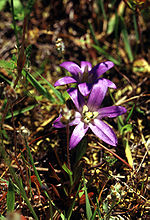
- Ithuriel's Spear (Triteleia spp.)
- Meadow OnionAllium monticolaAllium monticola is an uncommon species of wild onion known by the common name San Bernardino Mountains onion. It is endemic to southern California, where it is found only in the Transverse Ranges near Los Angeles and the northernmost section of the Peninsular Ranges. It generally grows in rocky...
(Allium monticola) - GoldenstarsBloomeria croceaBloomeria crocea, also known as Goldenstar, is a geophyte from southern California and northern Baja California. It is found along hillsides, in grassland and chaparral edges, and in dry flats.-Distribution:...
(Bloomeria crocea) - BrodiaeaBrodiaeaBrodiaea is a monocot genus of flowering plants in the family Asparagaceae, subfamily Brodiaeoideae, also known by the common name cluster-lilies...
s (Brodiaea spp.) - Blue Dicks-OokowDichelostemma capitatumDichelostemma capitatum , called Blue dicks, Purplehead and Brodiaea occur in Arizona, California, Oregon, Utah, New Mexico, and northern Mexico.-Subspecies:...
(Dichelostemma capitatum): one of the most common native bulb species throughout California; found in grasslandGrasslandGrasslands are areas where the vegetation is dominated by grasses and other herbaceous plants . However, sedge and rush families can also be found. Grasslands occur naturally on all continents except Antarctica...
and dry meadowMeadowA meadow is a field vegetated primarily by grass and other non-woody plants . The term is from Old English mædwe. In agriculture a meadow is grassland which is not grazed by domestic livestock but rather allowed to grow unchecked in order to make hay...
habitats; (Image: Blue Dicks returning in a thick stand in Ojai Valley after cattle grazing ceased.) - Mariposa LiliesCalochortusCalochortus is a genus of bulbous plants that includes 70 species from British Columbia to Guatemala and east to Nebraska. Calochortus is the most widely dispersed genus of Liliaceae on the North American Pacific coast. Of these, 28 species are endemic to California...
(Calochortus spp.): available from reputable horticultural sources; taking from the wild is illegal and is resulting in significant declines of some species from over collecting.
Common annuals and wildflowers
- Baby Blue Eyes (Nemophila menziesii)
- Blazing Star (Mentzelia lindleyi)Mentzelia lindleyiMentzelia lindleyi, is an annual wildflower found in the Coast ranges and San Joaquin Valley of California, and in Arizona....
- California Poppy (Eschscholzia californica)
- Chinese Houses (Collinsia heterophylla)Collinsia heterophyllaCollinsia heterophylla is a flowering plant native to California and Baja California. It is known as Purple Chinese Houses or Innocence...
- Elegant Clarkia (Clarkia unguiculata)Clarkia unguiculataClarkia unguiculata is a species of wildflower known by the common name elegant clarkia. This plant is endemic to California, where it is found in many woodland habitats. Specifically it is common on the forest floor of many oak woodlands, along with typical understory wildflowers that include...
- Farewell-to-spring (Clarkia amoena)Clarkia amoenaClarkia amoena is a flowering plant native to western North America, found in coastal hills and mountains from British Columbia south to the San Francisco Bay Area....
- Meadowfoam (Limnanthes douglasii)
- Miner's Lettuce (Claytonia perfoliata)Claytonia perfoliataClaytonia perfoliata is a fleshy annual plant native to the western mountain and coastal regions of North America from southernmost Alaska and central British Columbia south to Central America, but most common in California in the Sacramento and northern San...
- Tarweed (Madia elegans)Madia elegansMadia elegans is a species of flower in the daisy family. It is generally known as the common madia, but there are several subspecies known by various common names.-Range:...
- Wind Poppy (Stylomecon heterophylla)
Common vines
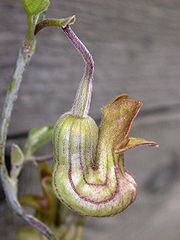
- Dutchman's Pipe VineAristolochiaAristolochia is a large plant genus with over 500 species. Collectively known as birthworts, pipevines or Dutchman's pipes, they are the namesake of the family . They are widespread and occur in the most diverse climates. Some species, like A. utriformis and A...
(Aristolochia spp.) - Morning GloryCalystegiaCalystegia is a genus of about 25 species of flowering plants in the bindweed family Convolvulaceae. The genus has a cosmopolitan distribution in temperate and subtropical regions, but with half of the species endemic to California...
(Calystegia spp.) - Chaparral Clematis (Clematis lasiantha)
- Western Virgin's BowerClematis ligusticifoliaClematis ligusticifolia is a climbing, spreading vine with showy flowers. It is also known as Old-man's Beard and Yerba de Chiva, and Virgin's bower,...
(Clematis ligusticifolia) - Calabazilla (Cucurbita foetidissima)Cucurbita foetidissimaCucurbita foetidissima is a xerophytic tuberous plant found in the southwestern USA and northwestern Mexico. A member of the cucumber family, the fruit is consumed by humans and animals. The fruit is eaten cooked like a squash when very young...
- Wild Cucumber-Manroot (Marah fabaceus)
- Cucamonga Manroot-BigrootMarah macrocarpusMarah macrocarpus, the Cucamonga Manroot or Bigroot, is the common manroot of most of Southern California and Baja California.-Foliage:...
(Marah macrocarpus) - California Wild GrapeVitis californicaVitis californica is a wild grape species native to most of California and southwestern Oregon. It is a deciduous vine which can grow to over 10 m in length. It climbs on other plants or covers the ground with twisted, woody ropes of vine covered in green leaves...
(Vitis californica) - Desert wild grapeVitis girdianaThe wild grape species Vitis girdiana is known as the desert wild grape and Southern California wild grape. It is quite similar to the California wild grape, Vitis californica...
(Vitis girdiana)
Common grasses
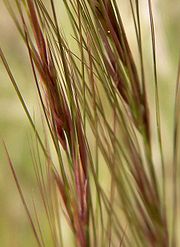
- Grasses:
- Purple three-awnAristida purpureaAristida purpurea is a species of grass native to North America which is known by the common name purple three-awn. This grass is fairly widespread and can be found across the western two thirds of the United States, much of southern Canada and parts of northern Mexico...
(Aristida purpurea) - Blue grama (Bouteloua gracilis)
- California fescueFestuca californicaFestuca californica is a species of grass known by the common name California fescue. It is native to the United Mexican States where it is a member of many plant communities, including chaparral. This fescue is a clumping bunch grass perennial without rhizomes.It reaches anywhere from 40 to 120...
(Festuca californica) - Idaho fescueFestuca idahoensisFestuca idahoensis is a species of grass known by the common names Idaho fescue and blue bunchgrass. It is native to western North America, where it is widespread and common...
(Festuca idahoensis) - Red fescueFestuca rubraFestuca rubra is a species of grass known by the common name red fescue. It is found worldwide and can tolerate many habitats and climates; it generally needs full sun to thrive...
(Festuca rubra) - JunegrassKoeleria macranthaKoeleria macrantha is a species of grass known by the common name prairie Junegrass. In the UK it is known as Crested hair-grass. It is native to much of North America, from Alaska to California, from northern Mexico to the Eastern United States...
(Koeleria macrantha) - Giant wildryeLeymus condensatusLeymus condensatus, with common name is Giant wildrye and syn. Elymus condensatus, is a wild rye grass native to California and northern Mexico.-Description:...
(Leymus condensatus) - California melicMelica californicaMelica californica is a species of grass known by the common name California melic.-Distribution:This grass is native to Oregon and California, where it grows in many types of habitat, from mountain forests to open grassland at sea level...
(Melica californica) - Deer grassMuhlenbergia rigensMuhlenbergia rigens, commonly known as Deergrass, is a warm season perennial bunchgrass found in sandy or well drained soils below in elevation in the Southwestern United States and parts of Mexico.-Description:...
(Muhlenbergia rigens) - Purple needlegrassNassella pulchraNassella pulchra is a species of grass known by the common name purple needlegrass. It is native to California, where it occurs throughout the coastal hills, valleys, and mountain ranges, as well as the Sacramento Valley and parts of the Sierra Nevada foothills, and Baja California.It grows in many...
(Nassella pulchra): The state grass of California. - Indian ricegrass (Oryzopsis hymenoides)
- Pine bluegrass (Poa secunda)Poa secundaPoa secunda is a widespread species of grass native to North America. It is highly resistant to drought conditions, and provides excellent fodder.-External links:**...
- Purple three-awn
- Grasslike:
- SedgesCarexCarex is a genus of plants in the family Cyperaceae, commonly known as sedges. Other members of the Cyperaceae family are also called sedges, however those of genus Carex may be called "true" sedges, and it is the most species-rich genus in the family. The study of Carex is known as...
— (Carex spp.) (taller 'bunch grass' specimens and lower meadow spreaders) - RushesJuncusJuncus is a genus in the plant family Juncaceae. It consists of some 200 to 300 or more species of grassy plants commonly called rushes...
— (Juncus spp.) - Western Blue-eyed Grass (Sisyrinchium bellum) and Yellow-eyed-grass (Sisyrinchium californicum).
- Sedges
Succulents
- Coast dudleyaDudleya caespitosaDudleya caespitosa is a succulent plant known by several common names, including Sealettuce, Sand lettuce, and Coast dudleya. It is endemic to California, where it grows along the coastline in the southern half of the state....
- (Dudleya caespitosa) - Canyon live-foreverDudleya cymosaDudleya cymosa is a succulent plant known by the common name Canyon live-forever. The plant is found in rocky areas in the low elevations of California and southern Oregon mountains.-Description:...
- (Dudleya cymosa) - FingertipsDudleya edulisDudleya edulis is a succulent plant known by the common name fingertips. This plant is native to Southern California and Baja California, where it grows in rocky areas of the coastal and the inland Peninsular Ranges mountains.-Description:...
- (Dudleya edulis) - Chalk lettuceDudleya pulverulentaDudleya pulverulenta is a succulent plant known by the common names chalk lettuce and chalk liveforever.-Distribution:This dudleya is native to the southwestern United States and northern Mexico, where it is found in steep open rocky areas in coastal and inland mountains and desert foothills, such...
- (Dudleya pulverulenta) - Coast sedumSedum oreganumSedum oreganum is a species of succulent plant of the genus Sedum. It grows along the Pacific Coast of North America from Alaska to far northern California. The plant, known by the common name Oregon stonecrop, grows in many types of rocky habitat, including coastal bluffs and cliffs and the talus...
- (Sedum oreganum)
Environmental challenges
Some California native plants are in rapid decline in their homeland from Urban sprawlUrban sprawl
Urban sprawl, also known as suburban sprawl, is a multifaceted concept, which includes the spreading outwards of a city and its suburbs to its outskirts to low-density and auto-dependent development on rural land, high segregation of uses Urban sprawl, also known as suburban sprawl, is a...
, agriculture, overgrazing, recreational impacts, and invasive non-native species
Invasive species
"Invasive species", or invasive exotics, is a nomenclature term and categorization phrase used for flora and fauna, and for specific restoration-preservation processes in native habitats, with several definitions....
(invasive exotics) colonization pressures. Public groups, Conservation foundations, and college programs are leading the awareness movement and actual projects for saving existing plant populations and restoring healthy habitats for present vitality and future thriving.
California also has 1,023 species of non-native plants, some now problematic Invasive species
Invasive species
"Invasive species", or invasive exotics, is a nomenclature term and categorization phrase used for flora and fauna, and for specific restoration-preservation processes in native habitats, with several definitions....
such as Yellow Starthistle, that were introduced during the Spanish colonization
Spanish colonization of the Americas
Colonial expansion under the Spanish Empire was initiated by the Spanish conquistadores and developed by the Monarchy of Spain through its administrators and missionaries. The motivations for colonial expansion were trade and the spread of the Christian faith through indigenous conversions...
, the California Gold Rush
California Gold Rush
The California Gold Rush began on January 24, 1848, when gold was found by James W. Marshall at Sutter's Mill in Coloma, California. The first to hear confirmed information of the gold rush were the people in Oregon, the Sandwich Islands , and Latin America, who were the first to start flocking to...
, and subsequent immigrations and import trading of the 18th-20th centuries.
See also
- Theodore PayneTheodore Payne FoundationThe Theodore Payne Foundation for Wild Flowers and Native Plants, is a private, non-profit organization founded in 1960 to promote the understanding and preservation of California native plants...
- California Native Plant SocietyCalifornia Native Plant SocietyThe California Native Plant Society is a California not-for-profit organization that seeks to increase understanding of California's native flora and to preserve that flora. Its "paramount purpose is to preserve wild plants".-History:...
External links
- Official California Native Plant Society website
- CalFlora homepage
- California Native Plant Link Exchange
- Native Revival Nursery
- Jepson Manual 'Flora Interchange'
- Las Pilitas Nursery: interactive Plant Database website
- Theodore Payne Foundation for Wildflowers and Native Plants
- California Native Grasslands Association: bunchgrass species & habitats.
Books: Flora
- A California Flora and Supplement, Philip A. Munz and David D. Keck, UC Press
- Grasses in California, Beecher Crampton, UC Press
- The Jepson Manual: Higher Plants of California, James C. Hickman (Editor), UC Press
- The Jepson Desert Manual: Vascular Plants of Southeastern California, Bruce Baldwin (Editor), UC Press
- Oaks of California, Bruce M. Pavlik, Pamela Muick, Sharon Johnson, Cachuma Press
- Plants of the San Francisco Bay Region: Mendocino to Monterey, Linda Beidleman, Eugene Kozloff, UC Press
Books: Gardening/Landscaping
- Landscape Plants for California Gardens, Bob Perry, Land Design Publishing
- California Native Plants for the Garden, Carol Bornstein, David Fross, and Bart O'Brien, Cachuma Press
- California Native Trees and Shrubs, Lee W. Lenz, Rancho Santa Ana
- Ceanothus, David Fross and Dieter Wilken, Timber Press
- Complete Guide to Native Perennials of California, Glenn Keator, Chronicle Books
- Complete Guide to Native Shrubs of California, Glenn Keator, Chronicle Books
- Designing California Native Gardens: The Plant Community Approach to Artful, Ecological Gardens, Glenn Keator and Alrie Middlebrook, UC Press
- Growing California Native Plants, Marjorie Schmidt, UC Press
- Native Landscaping From El Paso to L.A., Sally Wasowski and Andy Wasowski, McGraw-Hill
- Native Plants for California Gardens, Lee W. Lenz, Day Printing Corp.
- Native Treasures: Gardening with the Plants of California, M. Nevin Smith, UC Press

